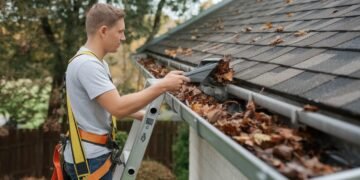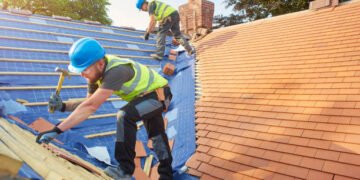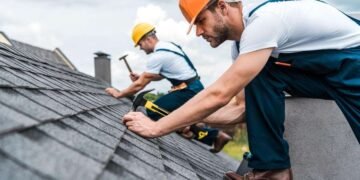Your home’s roof is one of its most crucial structural components. It protects you and your belongings from the elements, always ensuring comfort and safety. Given its critical role, keeping it in top shape is essential, making replacements inevitable at some stages. However, replacing a roof isn’t just about getting new shingles. It involves several factors, including materials, labor costs, location, and more. Given these elements are crucial, understanding them can help homeowners make informed decisions. Keep reading below as we delve into what goes into a roof replacement.
Understanding the Basics of Roofing
The world of roofing might seem complex, especially if you’re new to home renovations or repairs. Despite the plethora of information available, understanding the fundamentals can trim down your options, saving time and costs. The roof’s primary function is to provide protection. Functionality should be the priority before anything else, including aesthetics. For instance, you need a robust roof if you live in an area prone to severe weather conditions like hailstorms. Understanding these basics will steer you to the right path when you decide to replace your roof.
When choosing a roofing material, key considerations should include the local weather conditions, budget, and the aesthetic appeal you desire for your home. The material choice significantly impacts the roof replacement costs. Natural materials like wood, metal, and slate are more expensive but offer superior aesthetic appeal. Asphalt shingles are affordable and offer good durability, making them a popular choice among homeowners.
When it comes to size, the larger the home, the more materials and labor will be required, consequently adding to the costs. Gable roofs are less complicated and require less installation time than intricate designs like mansard roofs. Therefore, style and architecture play a role in determining the overall cost. You can use online tools like a roof replacement cost calculator for an accurate estimate.
Considering the Underlying Deck
Another crucial factor in roof replacements is the roofing deck. The deck is the wooden surface installed directly onto the roof’s structural components. The underlayment, shingles, or other roofing materials are installed over this deck. The deck material can vary, but wood is the most commonly used one.
Inspecting the underlying deck before installing a new roof is necessary to ensure it’s in good condition—any rot, damage, or sagging must be addressed. The deck’s state also affects the duration and complications of a roof replacement. A deck in poor condition may need repairs or replacement before installing a new roof, leading to extra costs.
A poorly installed or damp deck has a higher likelihood of causing roofing issues soon after the new installation. Investing in a good-quality deck is vital. This step might add to the initial costs but would lead to savings in the long run by preventing frequent or premature roof repairs or replacement.
Evaluating Labor Costs
A significant portion of your roof replacement cost will go toward labor. It generally constitutes about 60 percent of the total costs. Even though you may be tempted to make it a DIY project or hire cheap labor, remember that skill and experience are crucial to ensure a proper roof installation. An inadequately installed roof is more likely to encounter issues, subsequently leading to additional costs.

The labor cost also fluctuates depending on the complexity and size of the roof. Large roofs require more manpower and time, increasing labor costs. Construction complexities like chimneys, skylights, and the roof’s steepness can make installation more difficult, requiring specialized skills and equipment—resulting in higher labor costs.
The exact amount of labor will depend on individual contractors. Get estimates from different contractors to understand the average charges in your area. Always choose a roofing contractor licensed and insured to ensure quality work and protect yourself from any liability.
Considering Time and Season
The duration it takes to replace a roof can add to the total cost. While it may seem like this project could be over within a few days, sometimes it can take a week or more. Factors affecting the time include the roof’s size and complexity, weather conditions, and the contractor’s workforce size. A delay can translate into additional labor charges and inconvenience.
Also, the season in which you choose to replace the roof plays a role in the cost. Roofing contractors usually have their hands full during late summer and fall. This high demand can lead to increased prices.
However, although it might be tempting to schedule roof replacement during a less demanding season, remember that inclement weather can cause project delays. It may increase the project length, which might offset any financial savings from lower prices.
Rewarding Investment in Energy Efficiency
One of the advantages of roof replacement is the chance to improve your home’s energy efficiency. Energy-efficient roofing materials can reduce heating and cooling costs by reflecting sunlight away from the house, reducing the heat absorbed and thus the need for air-conditioning. They can make your home more comfortable while minimizing your carbon footprint.
While energy-efficient roofing materials may cost more upfront, they can save you money on your energy bills over time, making them a worthwhile investment. You may also qualify for federal tax credits for energy efficiency, further offsetting the installation costs.
No matter which roofing material you choose, ensuring proper installation is crucial for its performance. An energy-efficient roof poorly installed can result in underperformance, denying you the high-energy savings anticipated.
Dealing With Old Roof Removal
Before installing a new roof, the old one must be removed. The cost of removing the old roof depends on its size and complexity. Heavier roofs or those with multiple layers will be more costly to remove. The removal process involves not only removing the roof but also disposing of the old materials, which can also contribute to the cost.
Some roof contractors may recommend leaving the old roof in place and installing the new one on top. While this might reduce the upfront costs, it can lead to issues down the line. An old, damaged roof can cause the new roof’s premature failure. So removing the old roof before installing the new one is usually best.
Regulations and Permits
Just like any other major home improvement project, roof replacement also entails dealing with building codes and permits. Most communities have specific guidelines and regulations for this type of work to ensure safety and uniformity. You or your contractor will need to obtain a permit from the local building department before starting the work. The permit fees can contribute to the overall roof replacement cost.
The codes could also dictate the type of roofing material and the method of installation, particularly in areas prone to specific weather conditions like hurricanes or hailstorms. It’s crucial to understand and adhere to these guidelines to avoid fines or having to redo the job.
Insurance Coverage
Lastly, it’s important to consider whether your homeowner’s insurance policy covers roof replacement costs. For instance, if your roof needs replacement as a result of damage by a covered risk such as wind, storm, or fire, your insurer might foot the bill. However, if the roof replacement is due to wear and tear, you might have to shoulder the cost yourself.
Understanding your policy thoroughly or consulting your insurer to know what is covered is crucial. If a claim is necessary, get a quote from a reputable roofing contractor before filing. Some insurers might require you to use their approved contractors, while others may allow you to choose. Always make sure to go over these details with the insurance company.
Final Words
While the costs might seem substantial initially, considering the roof’s critical role in your home justifies the investment. A new and efficient roof enhances your home’s aesthetic appeal and adds to its value while offering comfort, security, and peace of mind.
Recommended Posts:















